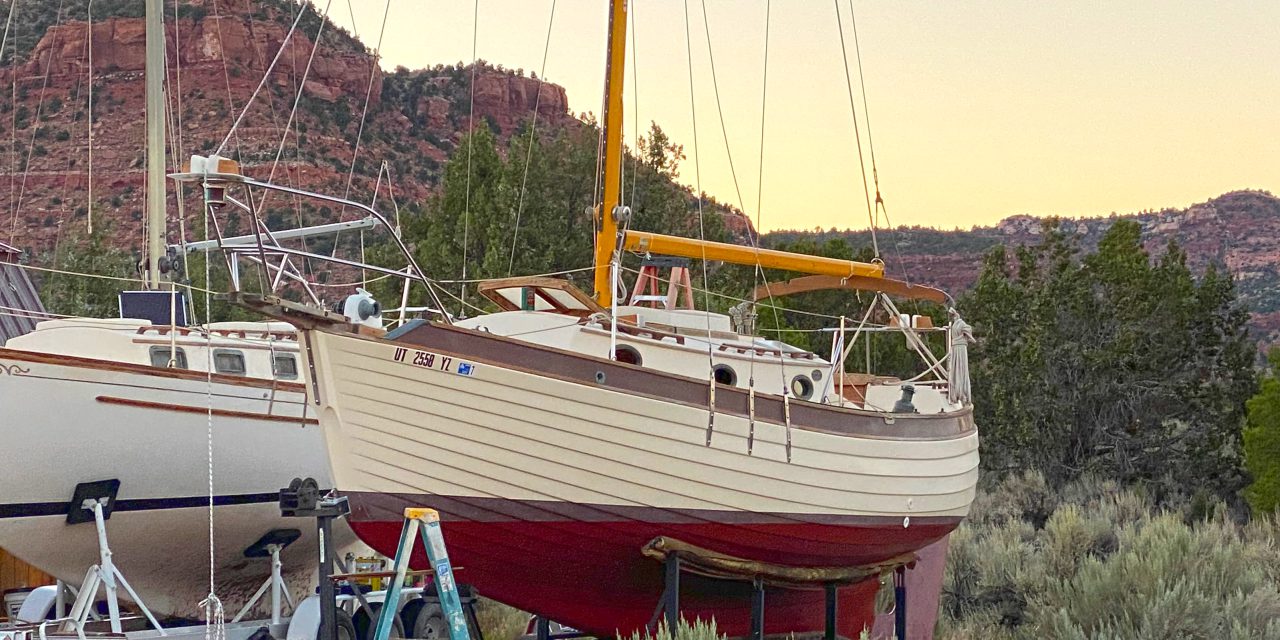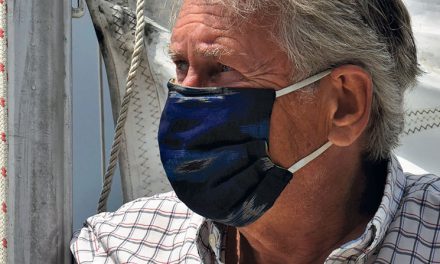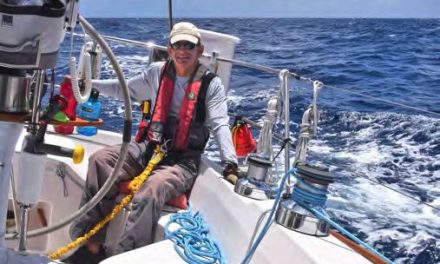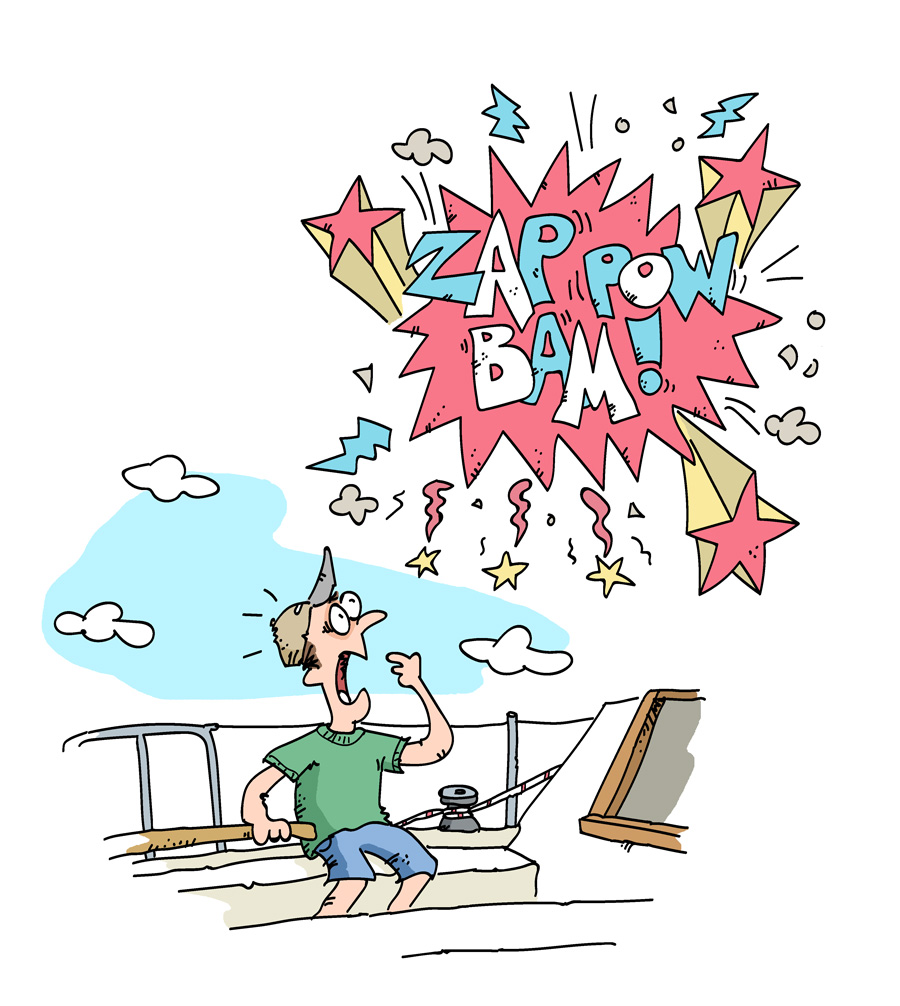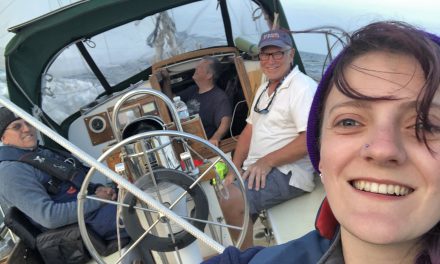A desert native goes cruising and takes a leap into unfamiliar territory
Issue 151: July/Aug 2023
The story starts in Kanab, Utah, where we bought a sailboat. Nobody thinks of sailboats when they think of Kanab. They think of John Wayne movies. They think of tumble- weeds tumbling by, coyotes yipping in the distance, cowboys driving the old dogies home. But we had sailboats on our minds, and Kanab was where we found a good one.
My husband, Guy, is always scanning the online classifieds, and he knew I’d love this little boat if I saw her. I’ve always been a sucker for beauty, even if I wasn’t much of a sailor. My husband and daughter were experienced trailer-sailors who had sailed in 11 lakes and bays across the country. That included the Great Salt Lake, known for the tiny tornadoes — dust devils — that spin out across the water from the desert; its oversalted, heavier-than-sea- water quality; and the shallows that create large and lasting waves. Both husband and daughter had become very skilled sailors, though they’d never been on the ocean.

Looking out Jackalope’s brass porthole windows in Kanab, Utah, where the boat was purchased.
I had been scared off by an early sailing trip on that very lake, one that had been too much, too soon; too much wind, too much sail, too many big waves. I hadn’t wanted to try sailing again for a very long time, but a few changes had taken place in my life that caused me to reconsider.
Our kids were grown and gone, and I was retired from raising and home- schooling them. I had nothing to do. I wanted Guy to be able to take the long sailing trip he’d been dreaming of. And I was ready to face the discomfort I felt when contemplating heavy weather and hard heeling. Guy could work from the road, or in this case, from the waterway, so nothing was keeping us pent up in the sagebrush but the lack of a good boat.
The boat we went to see was a Nor’Sea 27. She was a double-ended sloop with a lapstrake hull, a full keel with a cutaway forefoot, an open cockpit, and an aft cabin — a cream-colored beauty accented in brown, 27 feet long and 8 feet wide.
She was a fiberglass boat designed to look like a wooden boat. Adding to the illusion was the teakwood rubrail that protected her from bow to stern, the teak hatch up front, and a big teak bow pulpit. I’d be able to sit up there when we were underway and watch the dolphins jump below me. She was canoe-sterned, pointed on both ends. She had brass portholes that opened, six of them, and a big, fancy curl painted a shade of burnt amber on her molded rudder. Inside, her cabin was entirely paneled in cedar.

Jackalope getting ready to be trailered to the water.
Everything about her was glowing when we first met, the consistent effect of that pure desert light. “Yes, I could live on this boat,” I said.
As I said, I fall for beauty every time; I never give a thought to comfort or convenience until after the fact. This boat didn’t have refrigeration or interior heating or cooling. It didn’t have a stateroom. The aft cabin was the access to the diesel engine and would function as an engine room and critical storage. We would have to sleep scrunched up on the bow cushions. She had a foot pump for the kitchen sink and just enough electricity to run a few LED lights and charge our phones. Most severe of all was the powder room situation: just a portable toilet in a closet.
It turns out I’m not bothered by physical hardships of this kind. So I felt fine about the idea of living on this boat for a year. She was like a little westward-going wagon, my very own prairie schooner. We quickly relieved her of the name she’d been given when she had lived elsewhere. No longer would she be the anonymous Annalisa, but our little desert critter, Jackalope. “A jackalope, what’s that?” other boaters would ask. Then someone would walk by and pause. “Oh, wait, I know what that is,” he would say, remembering the time his family had taken a trip to Yellowstone when he was 10. “I saw a jackalope in a gift shop once … Are they real?”
Of course they’re real. A jackalope is a jackrabbit with tiny, forked antelope-style antlers. Examples of the mature male can be seen mounted on the walls of bars throughout the intermountain west. The females, which do not produce antlers, cannot be distinguished from jackrabbits. Plains Trading Post Restaurant in Douglas, Wyoming, will sell you a hunting license for jackalope in season.
A jackalope is an admirable creature. Noble. Strong. One inherently able to take a great leap. In certain circles it’s considered legendary.
That was she. That was us.
I would never have known it, but my desert life had prepared me well for a year of sailing. Living aboard Jackalope was simply camping out.

The mast is down, and the boat is ready for travel.
We had her trailered to north Mississippi, where she was put in the water at the top of the Tennessee-Tombigbee Waterway. Then we cut out to Florida, where we were able to raise main and jib to our hearts’ content. Our days were spent sitting in the open cockpit, climbing on deck to adjust sails and rigging, and navigating by channel markers and the digital charts on our phones. We sometimes sailed with dolphins, rays, manatees, or mullet.
Before sunset, we’d find a quiet cove and drop anchor, and there we’d stay for the night, floating in our liquid cul-de-sac, looking out at marsh grass or the mangroves while the sun did its spectacular work of setting. Sometimes we’d inflate the kayak and paddle to shore for a walk to the beach or the bar. I’d take some food from the ice chest — although we soon gave up on keeping ice in it — and cook a simple meal over a small alcohol stove. After dinner, I’d use that old-timey foot pump to fill the kettle with water, then wash dishes in the galley sink — washing carefully, conserving as you do in the desert.
East Coast boats have become complicated. There are boats out there with multiple staterooms, multiple kitchens, multiple wine fridges. You can be air-conditioned or central-heated to your exact comfort level. If you’re hooked up to the municipal water at a marina, you can shower on your boat. For an hour. Every day.
But bathing aboard Jackalope was like washing those dishes: You could do it if you could figure out how. And you could use a little trickle of fresh water, but you’d better use it wisely.
I’d sit in the cockpit with my swimsuit on, lather up body and hair with biodegradable soap and some sea water, and then jump overboard to rinse. But if you leave sea water on your skin, you’ll feel clammy and cold, even on a hot night, because the salt on your skin will continually attract the moisture in the humid air. You’ve got to use some of that precious fresh water from the tank to wipe the salt from your skin and rinse your hair. It’s a lot of work, and it left me jonesing for a real shower because I never really felt clean or dry.

Jackalope leaves sight of land to start her Gulf passage.
If in the desert we had once been considered some category of hippie, that judgment was intensified as we cruised on a small sailboat that lacked electronics and conveniences. Sure, we could have paid for marinas and had access to their bathhouses, but we didn’t want to spend the money required to do that; we were camping, for heaven’s sake. We liked the free anchorages. We liked drinking our ambient-temperature red wine on board; it made us look forward to cold beer on shore. We liked washing an occasional shirt in a bucket and hanging it on the safety lines with clothespins. We were sun bums, sailor trash, saltwater hippies.
But when we wanted showers, we couldn’t just turn on the hot water. We had to improvise.
Thus, I recalled that every beach has a public shower post near the parking lot. It’s got a low nozzle for rinsing the sand off your feet before you put your shoes back on, and a high nozzle for rinsing the sand and the salt off your body. I would use the high nozzle to its full potential. Soap up, rinse, even shave my legs — in a swimsuit, of course, No need to get a ticket for indecent exposure.
On a sailboat as in the desert: You walk on the sand. You search for the water.
When friends from Florida visited us in southern Utah, I’d expected them to be as impressed with our landscape of red rock cliffs and soaring sandstone towers as I am. Instead, they greeted us cautiously. They seemed blind to the beauty of the desert — it was the size that had gotten to them. I think they were experiencing a sudden fear caused by being able to see so much uninhabited land at one time. For people who were used to living on a flat peninsula studded with trees, there was simply too much to see here. The line of sight went on for 1,000 square miles. The vastness and the variations in altitude were too much.
Then there was the sparse population; I think it made them suspicious. What kind of nuts would actually live out here, they seemed to wonder, so far from civilization?
Our Florida friends had driven across Utah on I-80, and the only town they’d seen in 100 miles was Green River, a strip of gas stations that never has looked very welcoming. They had turned south at Fremont Junction and come up over Hogan Pass (still no towns), until they dropped down into Fremont, home to only a couple hundred people and a couple hundred milk cows. After crossing the entire county to get to us, they reported in astonishment that they’d seen exactly zero stoplights and two stop signs before they turned into the RV park.
Our friend Jan, looking nervously at an immense landscape of 11,000-foot flat-topped mountains, rows of red bluffs, lumps of purple bentonite clay, and tomato-colored Moenkopi stone towers, asked warily, “Where’s the grocery store?”
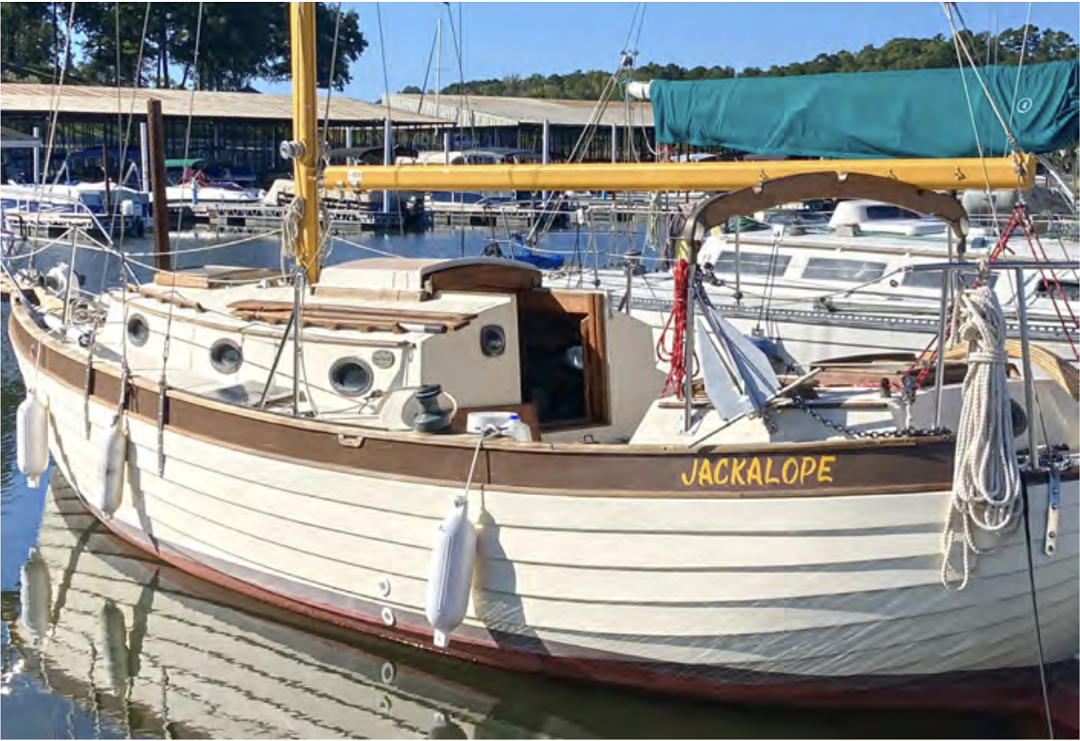
Jackalope is on the docks at a north Mississippi marina, awaiting the start of the trip down the Tenn-Tom Waterway.
I knew her motorhome was stocked with at least a week’s worth of food; there was something else behind her question.
“There’s one about 8 miles back the way you came,” I said, giving her room to say more.
“No,” she said quickly, “Not like that.” She must have seen our little Food Town market. “I mean a real grocery store,” she said. “Like a Walmart.”
And then she got to the point. “Where’s the hospital?”
The hospital is 60 miles to the west, over an uninhabited stretch of high- altitude plateau and through a canyon.
I knew she didn’t want to go to the hospital. She wanted the hospital and the Walmart to be close by in case she needed them. She wanted to establish a handrail. She was asking, “How did one hold on in this vast place?”
Agoraphobia isn’t just a fear of open spaces; it’s also the fear that one will be unable to escape whatever space one is in. Maybe the desert just strikes a visitor from a flat land as something too big to escape. Those fears are rational, really. It’s just that desert people get used to their unrelenting surroundings and experience them as a comfort.
At the time I thought it was a bit much, being wary of the desert. But I, too, would have an experience of a vastness that I couldn’t comprehend in my year of sailing on Jackalope.
It was my first passage on the Gulf of Mexico. We set out from a small town in the Florida Panhandle at sunset and would spend two nights on the water. That first night, alone on watch while the captain slept, Jackalope riding the swells, I had an intense experience of displeasure that didn’t match my surroundings. Dolphins were trailing the sailboat, jumping alongside her. The moon was out, full and slightly blurred by the humidity in the air, making the dolphins glow and the water glimmer.
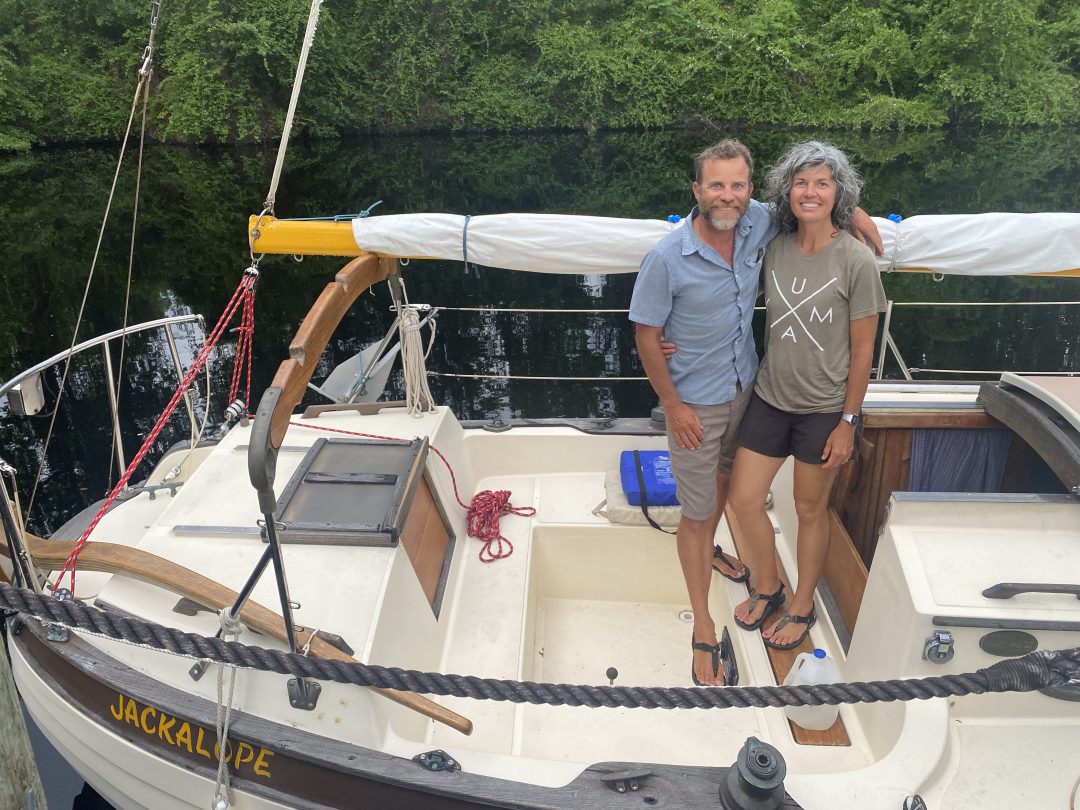
All three legendary creatures are captured in a single photo, tied to a free dock for a good night’s rest.
This scene, which I’d grown to believe had been invented just for T-shirts and paintings on black velvet in Tijuana, was real, and I was seeing it with my own eyes. But mingled with the mystery and thrill of being two people alone in a tiny vessel on a vast body of water was the sobering understanding that I could not escape.
It wasn’t a phobia. It was a fact.
That night on the Gulf, I had to put all my trust in Jackalope. I had to trust that although we thought of her as our little desert critter, she was really a native of this land of endless water. I had to trust that her lead keel would keep the bottom part down and the top part up. That her mast would stand steady and firm. That her hull would be sound against leaks. That her compass would aim true.
We did other passages that year, and each one was easier than the one before. I trusted Jackalope out on the water. But I was never truly comfortable. I kept my eyes peeled. I was wary. What kind of nuts, I wondered, actually glory in being all the way out here?
In the end, we parted ways. Jackalope wanted to stay on the ocean. I was ready to go home to the Utah desert, and my husband, who would have stayed on the water indefinitely, had work to do on land. Jackalope found new owners, people who also cherished her lapstrake and teak but would in all probability change her name.
We bid her goodbye on the docks and headed back to the desert. We were legendary creatures longing for that vast and barren landscape that felt like home.
Bianca Dumas was born and raised in a coal mining town in the Utah desert. Despite that geographical preference, she has traveled and adventured extensively, by land and by water, throughout the United States. She and her husband recently completed a yearlong, 6,000-mile sailboat cruising adventure on Jackalope.
Thank you to Sailrite Enterprises, Inc., for providing free access to back issues of Good Old Boat through intellectual property rights. Sailrite.com

